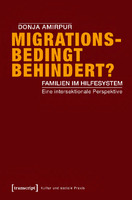Migrationsbedingt behindert?
Familien im Hilfesystem : Eine intersektionale Perspektive
| dc.contributor.author | Amirpur, Donja | |
| dc.date.accessioned | 2017-03-02 23:55 | |
| dc.date.accessioned | 2019-11-11 17:24:37 | |
| dc.date.accessioned | 2020-04-01T13:50:40Z | |
| dc.date.available | 2020-04-01T13:50:40Z | |
| dc.date.issued | 2016 | |
| dc.identifier | 624897 | |
| dc.identifier | OCN: 982239094 | en_US |
| dc.identifier.uri | http://library.oapen.org/handle/20.500.12657/31829 | |
| dc.description.abstract | Until now, the category of `culture' functioned as a central category of difference and explanation for reduced ability of the support system to reach families at the intersections of migration and disability. The barriers are alleged to be located above all within the family. Their culturally specific interpretation of disability, according to this assumption, does not correspond to the expectations of empowerment in disability services. To confront this one-dimensional perspective, Donja Amirpur illustrates the complex life situations of these families. Through interviews and with the help of an intersectional, multi-faceted analysis, she depicts the barriers in the support system, and promotes a critical confrontation with hegemonic practices on a structural level. | |
| dc.language | German | |
| dc.relation.ispartofseries | Kultur und soziale Praxis | |
| dc.subject.classification | thema EDItEUR::J Society and Social Sciences::JB Society and culture: general::JBF Social and ethical issues::JBFH Migration, immigration and emigration | en_US |
| dc.subject.classification | thema EDItEUR::5 Interest qualifiers::5P Relating to specific groups and cultures or social and cultural interests::5PB Relating to peoples: ethnic groups, indigenous peoples, cultures and other groupings of people::5PBC Relating to migrant groups / diaspora communities or peoples | en_US |
| dc.subject.other | cultural studies | |
| dc.subject.other | sociology | |
| dc.subject.other | anti-racism studies | |
| dc.subject.other | migration research | |
| dc.subject.other | inklusion | |
| dc.subject.other | migrationsforschung | |
| dc.subject.other | society | |
| dc.subject.other | körper | |
| dc.subject.other | soziologie | |
| dc.subject.other | behinderung | |
| dc.subject.other | intersectionality | |
| dc.subject.other | kulturwissenschaft | |
| dc.subject.other | body | |
| dc.subject.other | migration | |
| dc.subject.other | intersektionalität | |
| dc.subject.other | gesellschaft | |
| dc.subject.other | inclusion | |
| dc.subject.other | antirassismusforschung | |
| dc.subject.other | soziale ungleichheit | |
| dc.subject.other | disability studies | |
| dc.subject.other | social inequality | |
| dc.subject.other | Arzt | |
| dc.subject.other | Deutschland | |
| dc.subject.other | Türkei | |
| dc.title | Migrationsbedingt behindert? | |
| dc.title.alternative | Familien im Hilfesystem : Eine intersektionale Perspektive | |
| dc.type | book | |
| oapen.abstract.otherlanguage | Warum werden Familien an der Schnittstelle von Migration und Behinderung durch die Behindertenhilfe kaum erreicht? Fachliteratur und Wissenschaft scheinen sich einig zu sein: Sie sprechen von einer »kulturellen Fremdheit« der Familien, die den Zugang zum Hilfesystem behindere. Ähnlich ist die Meinung in den Diensten und Einrichtungen der Behindertenhilfe. Eine andere kulturspezifische Deutung von Behinderung, ein anderer Umgang mit dem behinderten Kind – das entspreche nicht der Vorstellung der Behindertenhilfe. Stimmen diese Annahmen? Die Studie von Donja Amirpur kommt zu anderen Ergebnissen. Sie illustriert die komplexen Lebenslagen der Familien. Entlang von biographischen Interviews und mit Hilfe einer intersektionalen Mehrebenenanalyse stellt sie die Barrieren im Hilfesystem dar und treibt die kritische Auseinandersetzung mit der hegemonialen Praxis auf Strukturebene voran. | |
| oapen.identifier.doi | 10.14361/9783839434079 | |
| oapen.relation.isPublishedBy | b30a6210-768f-42e6-bb84-0e6306590b5c | |
| oapen.relation.isFundedBy | 07f61e34-5b96-49f0-9860-c87dd8228f26 | |
| oapen.relation.isbn | 9783837634075;9783732834075 | |
| oapen.collection | Swiss National Science Foundation (SNF) | |
| oapen.pages | 312 | |
| oapen.place.publication | Bielefeld | |
| oapen.remark.public | Relevant Wikipedia pages: Arzt - https://de.wikipedia.org/wiki/Arzt; Behinderung - https://de.wikipedia.org/wiki/Behinderung; Deutschland - https://de.wikipedia.org/wiki/Deutschland; Türkei - https://de.wikipedia.org/wiki/T%C3%BCrkei | |
| oapen.identifier.ocn | 982239094 |

